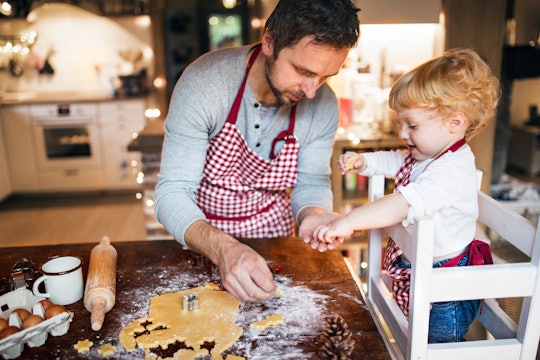Life

There's A Reason Learning Towers Are So Popular Right Now — The Benefits Are Huge
Little ones sometimes have a hard time accepting that they're not big enough to do certain things. Some kids have absolute meltdowns when they don't quite reach the height requirements to ride a big rollercoaster, or get frustrated when they can't see over the seat in front of them at the movie theater. It's hard being small in a big, big world, but thanks to the invention of learning towers, kids can experience a few activities that may have previously been out of reach. But how do learning towers benefit a kid?
"Learning towers help young children feel empowered and get the opportunity to develop fine motor skills (for example, helping in the kitchen under supervision). Young children that feel connected to their parents and see themselves as capable by accomplishing tasks grow in confidence, too," says Maureen Healy, author of The Emotionally Healthy Child and child development expert at Growinghappykids.com. "Said differently, the young child that uses a learning tower with supervision can accelerate their cognitive, social, emotional, and physical development."
If you aren't familiar with learning towers just yet, allow me to introduce you to this amazing parenting hack that you're going to be absolutely obsessed with. When your child isn't tall enough to reach up onto countertops, a learning tower can elevate them to counter height while keeping them contained and helping minimize the risk of falls that can occur with traditional stools. While they're not completely fool-proof, the addition of sides and steps can offer additional security for children while allowing them to participate in activities side-by-side with parents, caregivers, or older siblings.
"Parents can use learning towers to involve children in tasks such as washing vegetables at the kitchen sink, watering an herb garden at gardener's table, and folding laundry in the laundry room," Healy tells Romper. "Children that participate in everyday tasks with their parents develop a healthy connection to them while growing eye-hand coordination and learning the joy of accomplishing little to bigger things."
Learning towers have seen a surge in popularity since they first hit the parenting scene a few years back, with multiple manufacturers releasing their version of the product. Even former contestant on The Bachelorette Ali Fedotowski-Manno recently posted about her love of using a learning tower with daughter Molly.
Another cool benefit of adding a learning tower to your home is that they can transform into unique play spaces for children. Little Partners, the creators of The Original Learning Tower, also designed covers that can be slipped over the top of your child's tower to convert it into a pretend ice cream shop, lemonade stand, puppet show theater, popcorn stand, and more. This is a unique way to encourage your child to engage in pretend play and express their creativity.
Surprisingly, you don't have to shell out a ton of dough to cash in on the benefits of a learning tower for kids. My uncle spent no more than about three hours building a DIY learning tower for his son and says he spent approximately $30. His son used the learning tower for a few years and was able to help cook in the kitchen, play in a countertop sand bin, build LEGOs standing shoulder to shoulder with his big brother, and more. Compared to the retail cost of between $60 to $200, that's potentially a significant savings. I'm not entirely DIY-inclined, but I am all about saving money where I can, so if I can save money and my kid can reap serious developmental benefits, I'm willing to give it a try.
As with most every product on the market for kids, there are some safety risks to keep an eye out for when using a learning tower. "Learning towers help your son or daughter feel involved in daily activities, but they're not to be left unsupervised," Healy says. "They simply give your child height and the ability to participate in activities such as washing the salad at the kitchen sink, making holiday cards at the table with mom, or learning how to mix ingredients to bake brownies with dad. The upside of a learning tower is that it's much safer than simply a stool, but children still need constant supervision to stay safe and secure in their learning tower."
If you're ready to reap some serious developmental benefits for your kid, it may be time to look into a learning tower. Kids grow so fast, and before you know it they won't even need that extra step to help them reach the countertops, but until then you can use a learning tower to help foster their creativity, confidence, and independence.